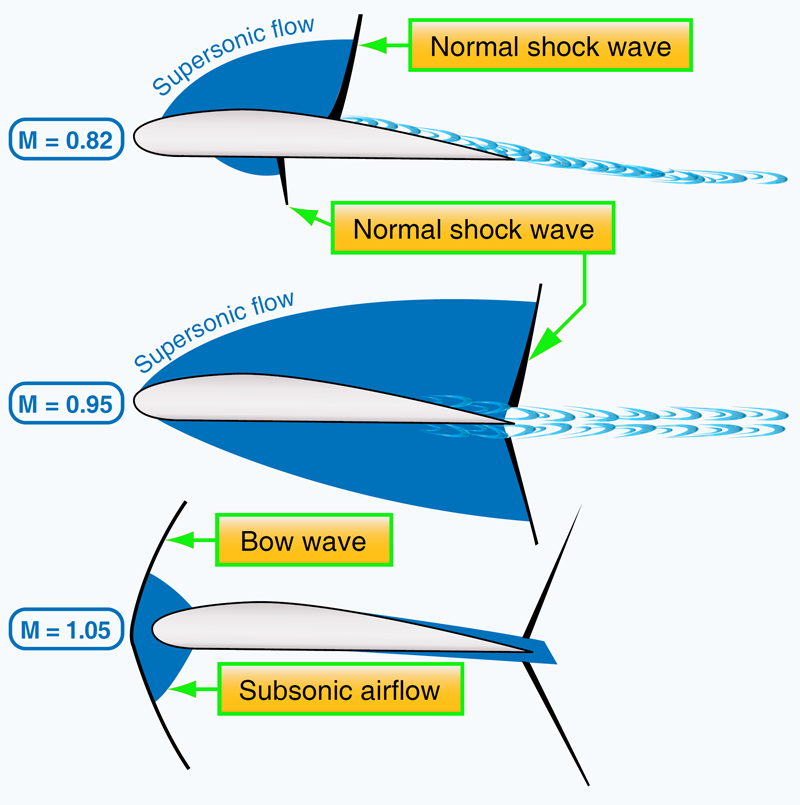It's been over two decades since the last commercial flight was taken by the Concorde, a 'supersonic' passenger aircraft that flew faster than the speed of sound. But if recent developments are anything to go by, the world is racing back into the high-speed skies at, well, supersonic speed, and we may soon be surrounded by the fastest and latest jets capable of breaking the sound barrier.
Our analysis is based on the stories that we have been hearing for some time. From the world's first supersonic private jet flight to Bombardier's Global 8000 and China's mind-bending 12,000 mph engine, the industry is buzzing with innovation. The question now is: are we on the verge of making hours-long flights a thing of the past?
 Supersonic flight occurs when an aircraft travels at a Mach number between 1.0 and 5.0. Image: Aircraft Systems Understanding Mach Speed
Supersonic flight occurs when an aircraft travels at a Mach number between 1.0 and 5.0. Image: Aircraft Systems Understanding Mach Speed
Before diving deeper into these developments, it's essential to understand what we mean by supersonic speed. The Mach number is defined as a plane's speed divided by the speed at which sound waves move through the air. For planes that fly less than 0.8, they're known as Subsonic - this includes most commercial aircraft today. Supersonic flights occur when the Mach number is between 1 and 5.0. Aircrafts designed for a supersonic flight feature thin airfoils, sharp edges, and canards to manage aerodynamics at extreme speeds.
Entering the Supersonic EraOn 28 January, American company Boom Supersonic flew faster than the speed of sound with its XB-1 supersonic demonstrator aircraft, reaching Mach 1.1 at an altitude of 35,000 feet over California's Mojave Desert. What makes this special is that unlike Concorde or military jets, the XB-1 is the first privately developed, piloted aircraft to go supersonic.
 In January, Boom's XB-1 completed its supersonic flight, reaching Mach 1.1, which is over 1,200 km/h. Image: Boom Supersonic
In January, Boom's XB-1 completed its supersonic flight, reaching Mach 1.1, which is over 1,200 km/h. Image: Boom Supersonic
Boom has already announced that the company aims to revive supersonic travel with a new airliner by 2030, so we could say that its latest supersonic flight is right in its ambitious direction.
The Future of High-Speed TravelThe Boom's XB-1 is designed to carry 64 to 80 passengers, making it smaller than the average commercial airliner today. The company said that it plans to operate Overture at Mach 0.94 over land and over water, where it would speed up to Mach 1.7 (over 2000 km/h) which is twice the speed of today's fastest commercial aircraft built by Airbus or Boeing. Imagine flying from Sydney to New York in half the time!
With a price tag of $200 million USD per jet, Boom is partnering with Kratos Defense & Security Solutions to develop engines inspired by F-22 and F-35 fighter jets. Airlines are already taking notice—American Airlines and Japan Airlines have placed orders for 130 aircraft, covering Boom's first five years of production.
Challenges AheadHowever, as exciting as it all sounds, the supersonic flight planes are going to face challenges – ones that Concorde struggled with decades ago - including high fuel consumption and high noise which severely limited the Concorde's operation in the past and contributed towards its demise.
 Boom Airways expects its Supersonic planes to be profitable at about $5,000 a seat. Image: Boom Supersonic
Boom Airways expects its Supersonic planes to be profitable at about $5,000 a seat. Image: Boom Supersonic
Noise pollution remains a major concern because when the Concorde was in operation, it made a thunderous noise when flying faster than Mach 1. This meant it was limited to flying faster than the speed of sound over the sea with only two routes, London to New York and Paris to New York. Boom Supersonic claims to have solved this with "Boomless Cruise" technology, but whether it can truly eliminate the disruptive noise remains to be seen.
Environmental concerns also loom large. Supersonic jets burn significantly more fuel than subsonic aircraft, raising concerns about carbon emissions at a time when the aviation industry is under pressure to go green. Several companies, including Aerion Supersonic and Exosonic, have already shut down due to financial and regulatory difficulties, proving just how tough this market can be.
How Much Will Tickets Cost?High costs are another challenge. In the late 1990s and early 2000s, tickets cost up to $12,000 round-trip, which would equal about $20,000 today when adjusted for inflation.
Boom expects the airlines to be profitable at about $5,000 USD a seat, which of course is a high price tag, and the company may find it hard to fill its plane seats with those who are willing to pay this price. First class passengers should expect to pay even more for the luxury of a premium cabin, although Boom hasn't yet crunched those numbers.
 The First Class cabin in the earlier Concorde models. Image: Lawrence Azerrad The Future Takes Flight
The First Class cabin in the earlier Concorde models. Image: Lawrence Azerrad The Future Takes Flight
Despite the roadblocks, the race to dominate high-speed commercial aviation intensifies as companies like Spike Aerospace are also developing their own supersonic designs, determined to bring high-speed travel back for good. The big question is whether these companies can succeed where the Concorde failed? Their fate will ultimately depend on whether they can balance speed, sustainability, and affordability.
Read the full article How Much First Class Tickets Cost On New $1 Billion Concorde Project on DMARGE. Don’t miss it!

0 Commentaires